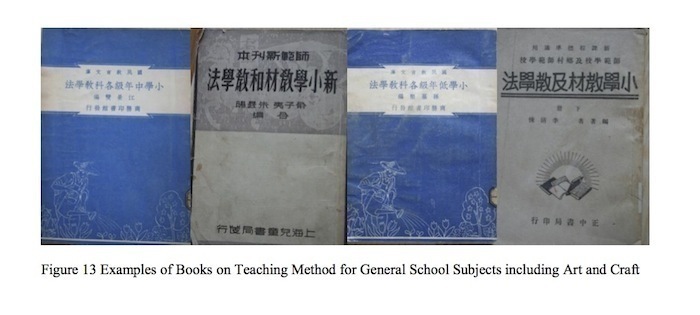by Yuk Lin Cheng
In early 20th century, the pace of Westernization became faster in China, more and more Chinese intellectuals took an active role in importing Western knowledge. Among the many Western knowledge, German philosophy, aesthetic theories and art educational ideas were also imported and began to play a role in constructing the rationale for Chinese art education. Ideas from Kant, Schopenhauer, Schiller, Volkelt, Weber, Herbert, Pestalozzi, Muensterberg, Lichtwark, Langer, Schalz and Dresdner, etc. could easily be found in many Chinese writings on art education and related areas. Generally speaking, importation of German ideas on art education by Chinese intelligentsia could be divided into two phases. German ideas on aesthetic and aesthetic education were introduced in the first decade of 20th century. This was the first phase. In the second phase, discussions about art education during the Kunsterziehungsbewegung (German art education movement) were imported in the second, third and fourth decades. In a historical perspective, importation of Western aesthetics had already taken place from late Ming to early Qing dynasty (17th to 18th century) and again in late Qing period (second half of 19th century), i.e. earlier than the periods stated above. While missionaries played a vital role in introducing Western aesthetics before 20th century, Chinese intellectuals began to take an active role in importing Western aesthetics, especially German aesthetics and the idea of aesthetic education, from the very beginning of 20th century. In this part of the ongoing study, focus is given to the first phase of the importation of German ideas on aesthetic and aesthetic education.
Main story
Importation of Western aesthetics in 17th and 18th centuries
In late Ming dynasty, more exactly, in the 1620s, Western missionaries such as Jules Aleni, Francois Sambiasi and Alphonse Vagnoni introduced Western knowledge including aesthetic to China. Characteristic of the aesthetic theories imported at that time were mainly ideas from St. Augustine, Pseudo-Dionysius and St. Thomas Aquinas. During the period of Mid-Qing, i.e. from late 18th century to mid 19th century, Western missionaries were banned in China. As a result, the importation of Western aesthetic discontinued. In 1844, after China’s defeat by Britain in the Opium War, Western missionaries became active again in China. In 1870s, Ernst Faber, one of the most prolific German Protestant missionaries in 19th-century China, introduced aesthetic in his Chinese writing Dadeguo xuexiao lunlüe (Schools in Great Germany) (1873) and Jiaohua lun (On Education) (1875). In his books, Faber defined aesthetics and created a new Chinese term Meixue to translate aesthetic.
The first phase
Wang Guowei was the key figure of the importation of Western, especially German aesthetic in the very beginning of 20th century. He was regarded as the first individual who introduced the term meiyu (aesthetic education) to China and employed Western, especially German thinkers’ ideas to carry out a systematic, although very brief, study on the significance of aesthetic education. Besides German aesthetic and aesthetic education, Wang Guowei had also introduced German philosophy and pedagogics. His contribution to the importation of German humanities had a very close relationship with the Journal Jiaoyu Shijie (Educational World). Jiaoyu Shijie was found in May 1901 and was the first Chinese journal dedicated to introduce Western education. Wang Guowei’s translations or writings on German studies were mostly published in this journal. In 1904, he became chief editor of Jiaoyu Shijie and thence became an influential figure of this journal and made significant contribution to introduce German philosophy, aesthetics and aesthetic education. As early as 1903, Wang published an article “Lun jiaoyu zhi zongzhi” (Discussion on objectives of education) in Jiaoyu Shijie. By means of using opinions by German philosophers Schiller and Schelling to explain the role of aesthetic education in general education, Wang introduced aesthetic education and German philosophers to China. In his other articles “Kongzi zhi meiyu zhuyi” (Confucius’s ideas on aesthetic education) (1904) and “Huoen shi zhi meiyu shuo” (Horne’s discussion on aesthetic education) (1907), Wang also used the ideas of Kant, Schopenhauer, Plato and Rousseau, in addition to those of Schiller, to discuss the values of aesthetic education. It is known that Wang learned Japanese and English. His command of these two languages thus became a tool to acquire knowledge on German aesthetics and ideas for his arguments for aesthetic education.
The timeline
|
dates |
Historical events |
People involved |
publications |
Key concepts |
|
Ming dynasty |
Western missionaries transmit Western knowledge while spreading Christianity in China |
Jules Aleni (It.), |
|
Western philosophy aesthetic |
|
Francois Sambiasi |
Transmitted orally by Francesco Sambiasi and written down by Xu Guangqi |
Beauty and desire |
||
|
Alphonse Vagnoni |
|
types of beauty |
||
|
Francois Furtado |
|
Definition of beauty |
||
|
Johan Adam Schall von Bell |
|
Types of beauty |
||
|
Late Qing period |
Ernst Faber |
|
Definition of beauty Definition of beauty |
|
|
Chinese intelligentsia played active role in importing Western aesthetic and aesthetic education |
Wang Guowei |
“Lun jiaoyu zhi zongzhi” (Discussion on objectives of education) (1903) “Kongzi zhi meiyu zhuyi” (Confucius’s ideas on aesthetic education) (1904) “Huoen shi zhi meiyu shuo” (Horne’s discussion on aesthetic education) (1907) |
Aesthetic education Value of aesthetic education Value of aesthetic education |

